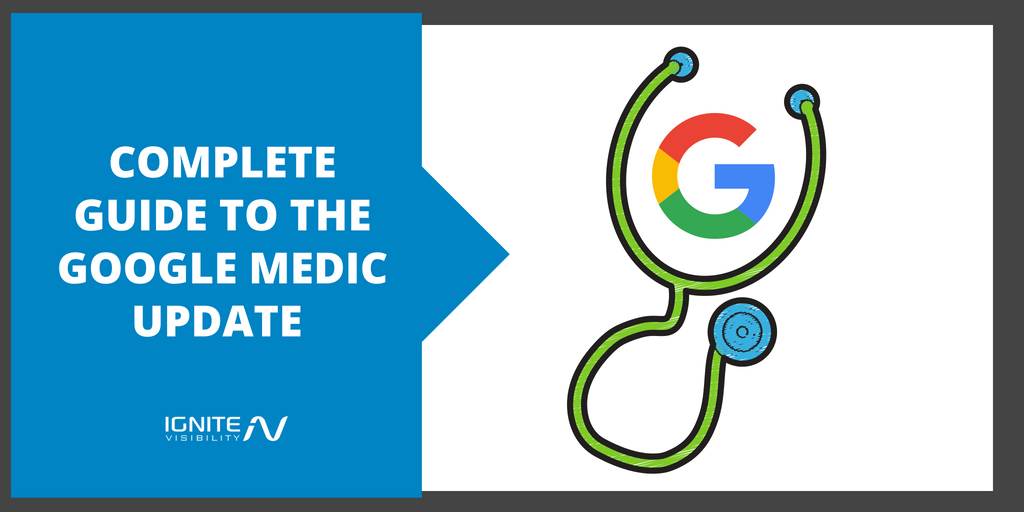If you’re noticing something different in the search rankings, there’s good reason for it.
Google recently confirmed its latest update, so get ready: it’s a big one.
In this article, I’ll cover everything you need to know about the Google Medic algorithm update.
What is the August 1st Google Medic Update?
The first iteration of the Medic update hit on July 22nd.
The update continued to roll out over the week, peaking on August 1-2nd.
What ensued was a few days of heavy rankings flux, confirmed in chat streams across the web and by Moz’s MozCast system.
MozCast predicts the “turbulence” of search rankings on a daily basis and saw a record heat spike of 114 degrees on August 1st and 2nd, unsurprisingly correlating with the latest news from Google.
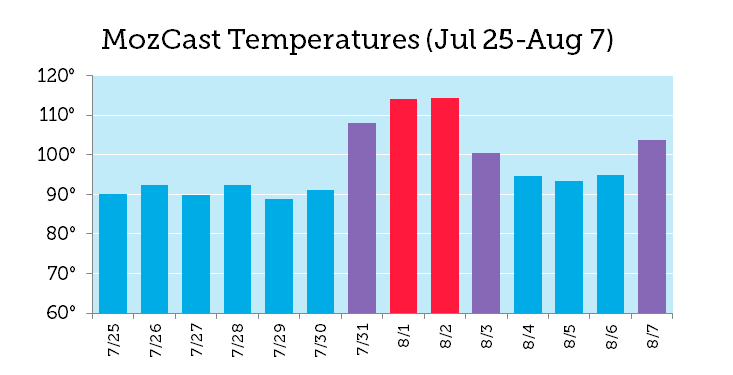
MozCast temperature correlates with the August 1st Google Medic update
All of this goes to show that this update certainly didn’t pass under the radar. In fact, it’s one of the biggest updates to hit in quite some time.
Google confirmed the update on the 2nd through this (largely unsatisfying) tweet:
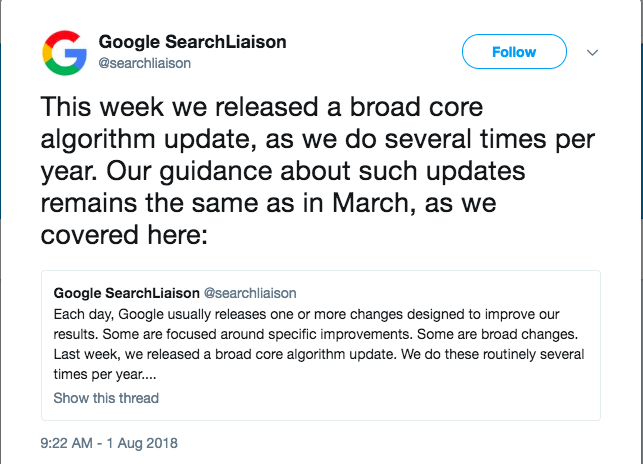
Google confirms its August 1st Medic update
So. Here’s what we know:
- Google’s classifying this update as a “broad core algorithm update.”
- This happens several times a year
- There’s no way to fix your site
Sound good?
Yeah. Most marketers didn’t think so either.
So let’s do a dive to uncover what exactly happened on August 2nd, and what steps you can take to protect your site and search rankings.
First, Who Did the Google Medic Algorithm Update Affect?
As you may have guessed, it’s nicknamed the “medic” update for a reason.
That reason being it largely targeted sites in the health and wellness industry.
In a review of over 300 sites, SEO Roundtable reported that a large percentage of the affected sites were in the medical, health, fitness, and healthy lifestyle space – over 42% total.
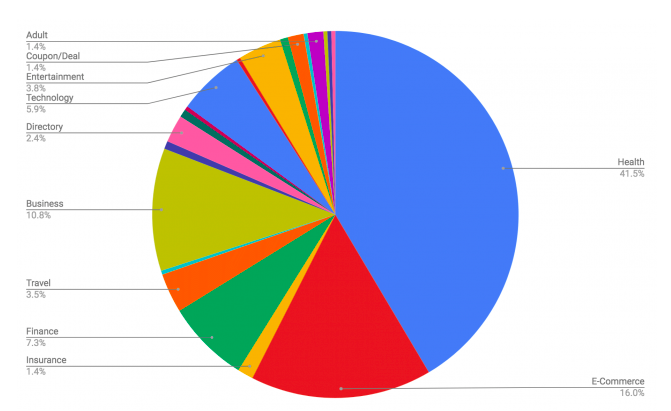
August 1st Google Medic update by industry, courtesy of SEORoundtable
Here’s what the MozCast temperatures looked like by industry:
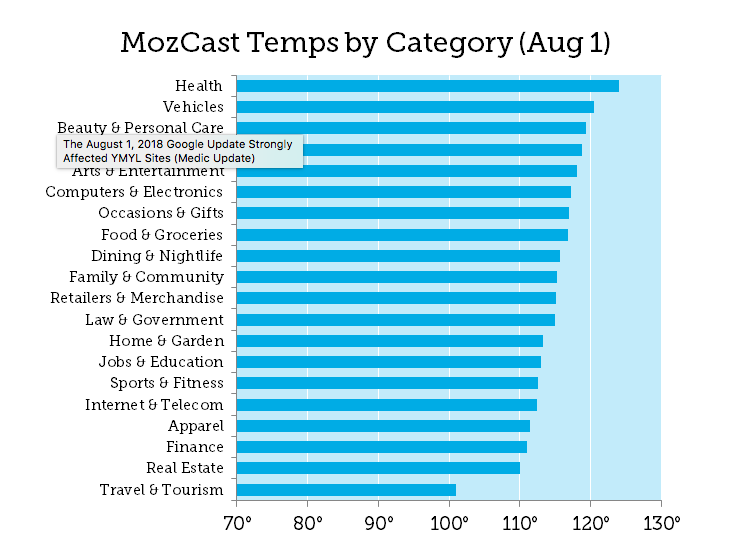
MozCast forecast of industries affected by the August 1st Google Medic update
Health is clearly at the top with keywords in that category hitting an average of 124 degrees, but it’s important to remember that other industries took their fair share of the brunt as well.
If you look at the comments and chatter around the web, many have theorized that the update was intended to bring more power to sites with higher authority like WebMD.
I tend to agree with them.
If you look at some of the sites hit the hardest, it appears that Google’s favoring the bigger sites with more domain authority in the rankings, while smaller sites with less authority suffered more from the Medic update.
Beyond that, pages coined Your Money or Your Life (YMYL) also saw some extreme fluctuations.
For reference, Google Quality Rater Guidelines refer to YMYL pages as ones that could “potentially impact the future happiness, health, financial security, or safety of users.”
Those sites typically do one of the following:
- Pages that solicit personal information, such as personal identification numbers, bank account numbers, drivers license numbers, etc., which could be used for identity theft.
- Pages used for monetary transactions, on which users might give their credit account or bank account information; for example any page that allows you to buy something.
- Pages that offer medical or health information that could impact your physical well being.
- Pages offering advice on major life decisions, such as pages on parenting, purchasing a home, a vehicle, etc.
- Pages offering advice on major life issues that could impact your future happiness and finances, such as pages giving legal or financial advice.
Moz put together a list of the 30 biggest winners and losers of the latest update.
Here are the winners:
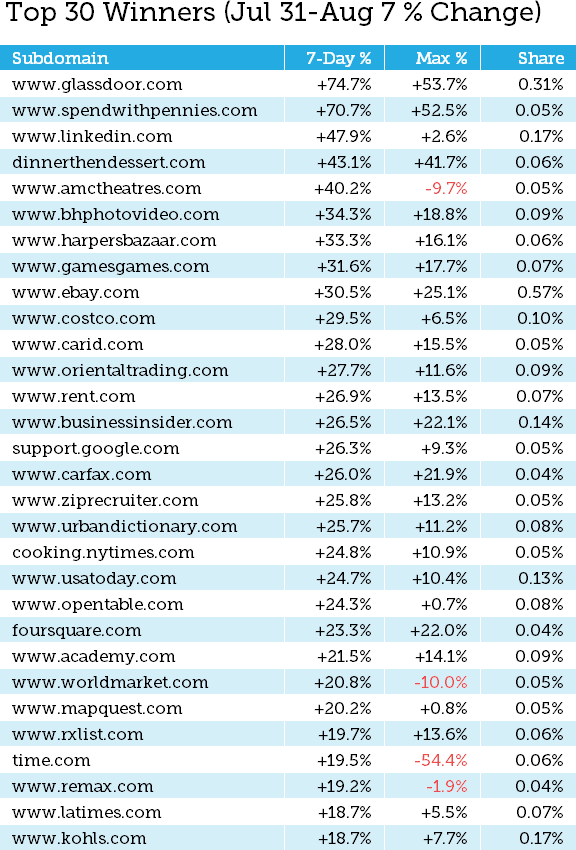
Websites with the most improvement due to the August 1st Google Medic update, courtesy of Moz
And the losers:
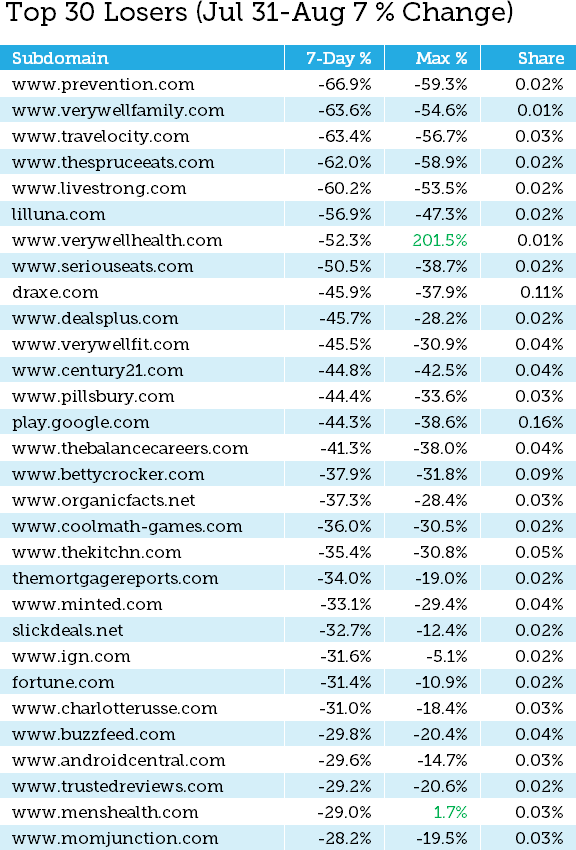
Websites with the most loss due to the August 1st Google Medic update, courtesy of Moz
As always, discretion is advised and the lists aren’t set in stone.
That said, it’s clear that a disproportionately large number of health sites found themselves on the losers list.
What makes these findings unusual is that so many of those hit come from a particular niche, whereas updates termed “broad core” generally don’t skew more towards one industry.
But Google’s sticking to its “broad core” guns.
I personally reached out via Twitter to inquire about any possible page speed connections.
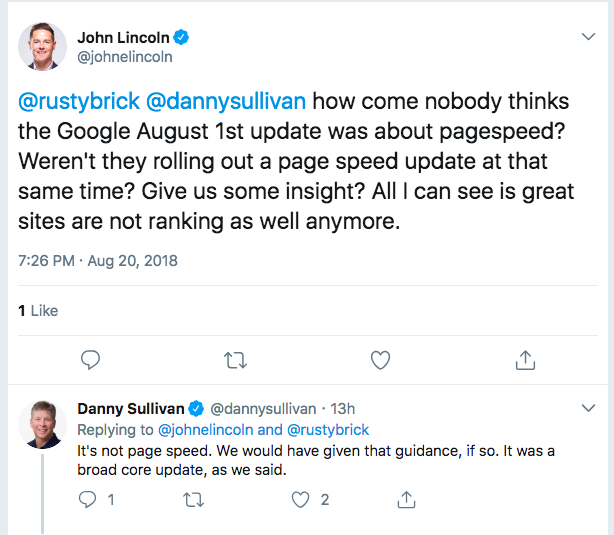
My question for Google regarding the August 1st Google Medic update
As you may know, Google recently announced that mobile page speed would become a ranking factor in July 2018, and it makes sense that it could somehow tie into this most recent update.
But no. According to Danny Sullivan’s reply, page speed wasn’t the issue.
It’s just “broad core”.
What is a Broad Core Algorithm Update?
Basically, it’s Google’s mystery brand.
It’s the kind of update that Google will confirm, but offer few details on what, specifically, has changed.
We saw a smaller update come through in March, and Google sent the following as an explanation:
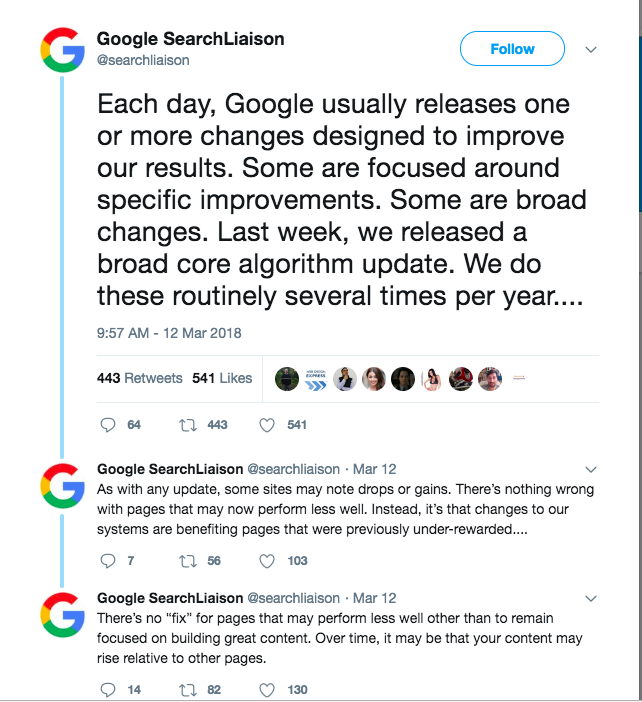
Google confirms an algorithm update in March, before the August 1st Medic update
As noted, Google makes changes on the daily.
They’re constantly updating their algorithm, and more often than not these tweaks go unnoticed by the majority of the web world.
Many of Google’s major algorithm updates are an effort to improve something specific.
Panda targeted content quality.
Penguin went after black hat linking tactics.
And way back in the beginning, Venice dealt with branding and sitewide authority.
And while no one’s ever thrilled to get hit with an update-related ranking loss, Google was transparent enough about the issues that sites were at least able to identify and work to reverse engineer the problem.
But a core algorithm doesn’t address any single factor.
In other words, it isn’t a punishment for bad behavior.
It’s more of a general clean up.
As Search Engine Land explains and understands it, a “core update is a tweak or change to the main search engine itself.”
Let’s break that down a bit.
Though Google’s algorithm remains a well-guarded secret, we do know it’s made up of several hundred ranking factors (how many, only Google knows, though it likely lies between 200-500).
Those factors include things like:
- Page speed
- Mobile responsiveness
- HTTPS
- Keywords in title tags
- ..and a few hundred more
So in a core algorithm update, Google tweaks how they value each factor.
Before, Page Speed (X) factor may have carried more weight than HTTPS (Y). But now, Y carries more weight than X.
Apply that to a couple hundred factors, and you can see how that could throw a few rankings out of whack.
Again, it doesn’t mean the site that suffered from the update did anything wrong.
Google just made a judgment call, and decided it was putting more value in a different set of factors that maybe a competitor excels at.
How to Recover From the August 1st Google Medic Update
This is possibly the most frustrating aspect of the Medic update.
Because according to Google, you can’t fix it, and there’s nothing really wrong with your pages. They just aren’t performing as well as other pages now.
As Google puts it, it means that “changes to our systems are benefitting pages that were previously unrewarded.”
And as always, they advise sticking to creating great content, in the hopes it that eventually rise relative to other pages.
This is why updates like Panda and Penguin were far less confusing: with them, we knew the root cause and could formulate strategies to fix our links, content, etc. to better meet Google’s new standards.
But all hope’s not lost.
We know enough about to Google to at least theorize a few possible cause and effect scenarios.
August 1st Google Medic Update: Focus on E.A.T.
For some of the biggest hints, we have to look at Google’s gold standard: its Quality Rater Guidelines.
The Guidelines underwent updates as recently as July of this year, stressing the importance of expertise, authoritativeness, and trust (E.A.T).
Google is committed to returning the most authoritative and relevant results for its users. Which means that everything you produce – whether it’s a post or product – needs serious credibility.
For starters, each site needs an About page that puts the spotlight on how seriously qualified your business is and highlights any awards or recognition it’s received.
The golden rule here is this: if you got it, flaunt it.
Here’s an interesting example from Marie Haynes. She reports the site that used to rank #1 for the term “keto diet” took a significant hit:
Despite its wealth of quality content, it took a massive hit from the Google Medic update:
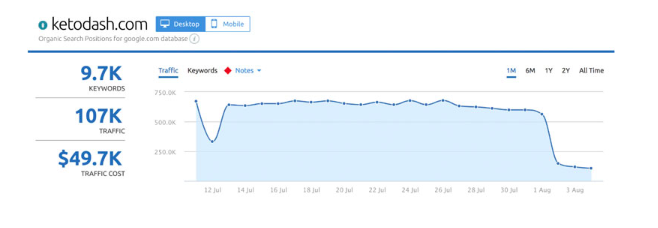
The Google Medic update on August 1st hit some sites hard
Upon further investigation, she theorized that the major culprit was a lack of E.A.T: no About page, little external reputation, and a product recommendation that may go against a scientific consensus.
On the other hand, the site that ranks number one post-Medic update features expert author bios and clear signs of authority.
While we can’t know if this is, in fact, the major aim of the Medic update, based on the information above it seems reasonable that overall authority is a big goal of Google’s.
Along those lines, one of the bigger changes in the Guidelines is that Google’s not just considering the reputation of the website itself, but the reputation of each individual author associated with the site.
Which means if your site features work from multiple authors, each needs a well-rounded authors bio that also heavily emphasizes their credibility.
For many, that will mean a more rigorous screening process when accepting articles from contributors and guest bloggers.
And, if possible, work on gaining positive press that you can display and use on your site.
That means everything from applying for awards to soliciting as many positive reviews of your business or product as possible.
All of the above – more credible authors, readily available proof of expertise, and a solid collection of positive reviews – will help improve your E.A.T. and, hopefully, your rank.
Google’s also cracking down harder on anything its raters deem as “clickbait,” which means content creators should pay special attention to headlines and making sure they match the content on the page.
Unfortunately, this will be easier for some than others. Smaller, local sites and businesses will have a harder time establishing the same kind of authority that comes more easily to its larger counterparts.
No matter what size, a hard look through Google’s Quality Rater Guidelines (all 196 pages of them!) is one of your best bets in deciphering the method behind the madness.
Make Sure Your Quality Matches User Intent to Help Beat the Google Medic Update
The whole idea behind E.A.T, as stated above, is to help deliver the most trustworthy and relevant content for each search query.
And really, that all comes down to how well your content matches your users intent.
For example, if someone’s searching for the keyword “bug,” are they looking for the insect, the car, an illness, or a computer defect?
If you’re selling the car, you need to make sure the searcher finds you, not of the online insect Encyclopedia.
Beyond that, you need to know if the searcher is looking to buy or if they’re looking for information.
You can differentiate the two through keyword selection.
Keywords like “buy,” “affordable,” and “discount,” signal purchase intent, while keywords like “what is..,” “top 10,” or “reviews” or “examples” signal an informational query.
For reference, the Needs Met Rating covers Part 3 of Google’s Guidelines, with a scale ranging from Fully Meets to Fails to Meet.
And while producing high-quality content remains a top priority, content creators and marketers need to pay just as much attention to whether or not that content matches the intent of the user.
Search Engine Journal has a great article on how to decipher – and meet – user intent here.
Here’s one more thing: when you look at the breakdown of your website, you’ll find that only about 20% of pages drive the bulk of all traffic.
Those are the pages you need to be focusing on.
Consistently work on page refreshes and link outreach to make sure their domain authority is improving.
Key Takeaways from the Google Medic Update
Here’s a brief rundown of what we covered:
- Google confirmed its latest “broad core algorithm update” on August 2nd
- They didn’t give any specific information on what’s causing rank fluctuation for sites, and there’s no way to “fix” pages that were hit
- The health and wellness industries seem to have been hit the hardest by the update, followed by some in the YMYL category
- Pay special attention to Google’s Quality Raters Guidelines for clues on how to improve
- Focus on improving domain authority: Add in proof of expertise and authority wherever possible on your site, including individual author bio’s
- Focus on aligning your content with user intent
- Continue to focus on known algorithm factors like PageSpeed, HTTPS, mobile responsiveness, and making sure your site is technically correct
Concluding Google’s Medic Update
The Google Medic update is one for the books.
It hit the health and wellness industry harder than most, but still affected sites across the board.
And while there’s no exact cause or remedy to regain lost traffic, by sticking to the principles outlined in the updated Quality Raters Guidelines, you can set yourself up for higher rankings in the future.
Remember, as with any updates things will fluctuate for a while before regaining equilibrium.
But don’t stand idly by, and don’t take Google’s “there is no fix” claims as an excuse to do nothing.
Instead, work harder.
Work harder to build a quality site that’s technically sound. Fill it with bulletproof content that’s relevant to your reader’s needs.
Over time, Google will take notice.
